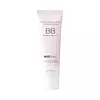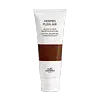What's inside
What's inside
 Key Ingredients
Key Ingredients

 Benefits
Benefits

 Concerns
Concerns

 Ingredients Side-by-side
Ingredients Side-by-side

Water
Skin ConditioningCyclopentasiloxane
EmollientTitanium Dioxide
Cosmetic ColorantButylene Glycol
HumectantCyclohexasiloxane
EmollientEthylhexyl Methoxycinnamate
UV AbsorberZinc Oxide
Cosmetic ColorantCyclomethicone
EmollientCaprylic/Capric Triglyceride
MaskingArbutin
AntioxidantCetyl PEG/PPG-10/1 Dimethicone
Emulsifying4-Methylbenzylidene Camphor
UV AbsorberDimethicone
EmollientOzokerite
Emulsion StabilisingPEG-10 Dimethicone
Skin ConditioningCI 77492
Cosmetic ColorantSodium Chloride
MaskingPhenoxyethanol
PreservativeSorbitan Sesquioleate
EmulsifyingIsododecane
EmollientMethicone
EmollientCI 77491
Cosmetic ColorantTriethoxycaprylylsilane
CI 77499
Cosmetic ColorantPEG/PPG-19/19 Dimethicone
EmulsifyingHydrolyzed Collagen
EmollientSodium Hyaluronate
HumectantXanthan Gum
EmulsifyingDisteardimonium Hectorite
StabilisingParfum
MaskingAdenosine
Skin ConditioningPropylene Carbonate
SolventButylphenyl Methylpropional
PerfumingBenzyl Benzoate
AntimicrobialAlpha-Isomethyl Ionone
PerfumingCitronellol
PerfumingGeraniol
PerfumingWater, Cyclopentasiloxane, Titanium Dioxide, Butylene Glycol, Cyclohexasiloxane, Ethylhexyl Methoxycinnamate, Zinc Oxide, Cyclomethicone, Caprylic/Capric Triglyceride, Arbutin, Cetyl PEG/PPG-10/1 Dimethicone, 4-Methylbenzylidene Camphor, Dimethicone, Ozokerite, PEG-10 Dimethicone, CI 77492, Sodium Chloride, Phenoxyethanol, Sorbitan Sesquioleate, Isododecane, Methicone, CI 77491, Triethoxycaprylylsilane, CI 77499, PEG/PPG-19/19 Dimethicone, Hydrolyzed Collagen, Sodium Hyaluronate, Xanthan Gum, Disteardimonium Hectorite, Parfum, Adenosine, Propylene Carbonate, Butylphenyl Methylpropional, Benzyl Benzoate, Alpha-Isomethyl Ionone, Citronellol, Geraniol
Water
Skin ConditioningMethyl Trimethicone
Skin ConditioningNeopentyl Glycol Diethylhexanoate
EmollientMica
Cosmetic ColorantDimethicone
EmollientDipropylene Glycol
HumectantPEG-10 Dimethicone
Skin ConditioningCyclopentasiloxane
EmollientVinyl Dimethicone/Methicone Silsesquioxane Crosspolymer
Pentylene Glycol
Skin ConditioningButylene Glycol
HumectantGlycerin
HumectantPhenoxyethanol
PreservativeSorbitol
HumectantPolyglyceryl-2 Diisostearate
EmulsifyingSodium Citrate
BufferingTrimethylsiloxysilicate
EmollientDisteardimonium Hectorite
StabilisingSodium Chloride
MaskingParfum
MaskingCaprylic/Capric Triglyceride
MaskingTocopherol
AntioxidantDimethicone/Vinyl Dimethicone Crosspolymer
Skin ConditioningGlycine
BufferingBenzyl Salicylate
PerfumingSodium Hyaluronate
HumectantScutellaria Baicalensis Root Extract
AstringentLimonene
PerfumingOenothera Biennis Seed Extract
Skin ConditioningMorus Alba Bark Extract
Skin ConditioningGeraniol
PerfumingCitronellol
PerfumingLinalool
PerfumingHydroxycitronellal
PerfumingCI 77891
Cosmetic ColorantCI 77491
Cosmetic ColorantWater, Methyl Trimethicone, Neopentyl Glycol Diethylhexanoate, Mica, Dimethicone, Dipropylene Glycol, PEG-10 Dimethicone, Cyclopentasiloxane, Vinyl Dimethicone/Methicone Silsesquioxane Crosspolymer, Pentylene Glycol, Butylene Glycol, Glycerin, Phenoxyethanol, Sorbitol, Polyglyceryl-2 Diisostearate, Sodium Citrate, Trimethylsiloxysilicate, Disteardimonium Hectorite, Sodium Chloride, Parfum, Caprylic/Capric Triglyceride, Tocopherol, Dimethicone/Vinyl Dimethicone Crosspolymer, Glycine, Benzyl Salicylate, Sodium Hyaluronate, Scutellaria Baicalensis Root Extract, Limonene, Oenothera Biennis Seed Extract, Morus Alba Bark Extract, Geraniol, Citronellol, Linalool, Hydroxycitronellal, CI 77891, CI 77491
 Reviews
Reviews

Ingredients Explained
These ingredients are found in both products.
Ingredients higher up in an ingredient list are typically present in a larger amount.
Butylene Glycol (or BG) is used within cosmetic products for a few different reasons:
Overall, Butylene Glycol is a safe and well-rounded ingredient that works well with other ingredients.
Though this ingredient works well with most skin types, some people with sensitive skin may experience a reaction such as allergic rashes, closed comedones, or itchiness.
Learn more about Butylene GlycolThis ingredient is an emollient, solvent, and texture enhancer. It is considered a skin-softener by helping the skin prevent moisture loss.
It helps thicken a product's formula and makes it easier to spread by dissolving clumping compounds.
Caprylic Triglyceride is made by combining glycerin with coconut oil, forming a clear liquid.
While there is an assumption Caprylic Triglyceride can clog pores due to it being derived from coconut oil, there is no research supporting this.
Learn more about Caprylic/Capric TriglycerideCi 77491 is also hydrated iron III oxide. It's sole purpose is to give a red/pink hue to products.
Iron III oxides are classified as inorganic chemicals for coloring.
Synthetically created Ci 77491 is considered safer than those naturally found. This is because the synthetically created version may contain less impurities. Iron oxides are generally non-toxic and non-allergenic.
Learn more about CI 77491Citronellol is used to add fragrance/parfum to a product. It is often derived from plants such as roses. In fact, it can be found in many essential oils including geranium, lavender, neroli, and more. The scent of Citronellol is often described as "fresh, grassy, and citrus-like".
Since the Citronellol molecule is already unstable, Citronellol becomes irritating on the skin when exposed to air.
Citronellol is a modified terpene. Terpenes are unsaturated hydrocarbons found in plants. They make up the primary part of essential oils.
Citronellol is not able to be absorbed into deeper layers of the skin. It has low permeability,
Citronellol is also a natural insect repellent.
Learn more about CitronellolCyclopentasiloxane, or D5, is a silicone used to improve texture of products and trap moisture.
D5 is considered lightweight and volatile. Volatile means it evaporates quickly after application. Once evaporated, D5 leaves a thin barrier that helps keep skin hydrated.
It is also an emollient. Emollients help soften the skin and prevent water loss. Silicones create a silky texture in products. D5 helps other ingredients become more spreadable.
Studies show D5 is safe to use in skincare products. We recommend speaking with a skincare professional if you have concerns.
Learn more about CyclopentasiloxaneDimethicone is a type of synthetic silicone created from natural materials such as quartz.
What it does:
Dimethicone comes in different viscosities:
Depending on the viscosity, dimethicone has different properties.
Ingredients lists don't always show which type is used, so we recommend reaching out to the brand if you have questions about the viscosity.
This ingredient is unlikely to cause irritation because it does not get absorbed into skin. However, people with silicone allergies should be careful about using this ingredient.
Note: Dimethicone may contribute to pilling. This is because it is not oil or water soluble, so pilling may occur when layered with products. When mixed with heavy oils in a formula, the outcome is also quite greasy.
Learn more about DimethiconeDisteardimonium Hectorite comes from the clay mineral named hectorite. It is used to add thickness to a product.
It can also help stabilize a product by helping to disperse other ingredients.
Hectorite is a rare, white clay mineral.
Learn more about Disteardimonium HectoriteGeraniol is used to add fragrance/parfum to a product. It is the main component of citronellol. It is a monoterpenoid and an alcohol.
Monoterpenes are naturally found in many parts of different plants.
Geraniol can be found in many essential oils including Rose Oil and Citronella Oil. The scent of Geraniol is often described as "rose-like". Many foods also contain Geraniol for fruit flavoring.
Geraniol can irritate the skin when exposed to air. However, irritation depends on the ability of geraniol to penetrate into the skin. In general, geraniol is not able to penetrate skin easily.
Geraniol is colorless and has low water-solubility. However, it is soluble in common organic solvents.
Like citronellol, it is a natural insect repellent.
2,6-Octadien-1-ol, 3,7-dimethyl-, (2E)-
Learn more about GeraniolParfum is a catch-all term for an ingredient or more that is used to give a scent to products.
Also called "fragrance", this ingredient can be a blend of hundreds of chemicals or plant oils. This means every product with "fragrance" or "parfum" in the ingredients list is a different mixture.
For instance, Habanolide is a proprietary trade name for a specific aroma chemical. When used as a fragrance ingredient in cosmetics, most aroma chemicals fall under the broad labeling category of “FRAGRANCE” or “PARFUM” according to EU and US regulations.
The term 'parfum' or 'fragrance' is not regulated in many countries. In many cases, it is up to the brand to define this term.
For instance, many brands choose to label themselves as "fragrance-free" because they are not using synthetic fragrances. However, their products may still contain ingredients such as essential oils that are considered a fragrance by INCI standards.
One example is Calendula flower extract. Calendula is an essential oil that still imparts a scent or 'fragrance'.
Depending on the blend, the ingredients in the mixture can cause allergies and sensitivities on the skin. Some ingredients that are known EU allergens include linalool and citronellol.
Parfum can also be used to mask or cover an unpleasant scent.
The bottom line is: not all fragrances/parfum/ingredients are created equally. If you are worried about fragrances, we recommend taking a closer look at an ingredient. And of course, we always recommend speaking with a professional.
Learn more about ParfumPeg-10 Dimethicone is silicone with conditioner and emulsifier properties. It mostly acts as an emollient in skincare and and humectant in haircare.
According to the manufacturer, acidic formulations decrease the stability of this ingredient. It works best in neutral or near neutral formulations.
Phenoxyethanol is a preservative that has germicide, antimicrobial, and aromatic properties. Studies show that phenoxyethanol can prevent microbial growth. By itself, it has a scent that is similar to that of a rose.
It's often used in formulations along with Caprylyl Glycol to preserve the shelf life of products.
Chances are, you eat sodium chloride every day. Sodium Chloride is also known as table salt.
This ingredient has many purposes in skincare: thickener, emulsifier, and exfoliator.
You'll most likely find this ingredient in cleansers where it is used to create a gel-like texture. As an emulsifier, it also prevents ingredients from separating.
There is much debate on whether this ingredient is comedogenic. The short answer - comedogenic ratings don't tell the whole story. Learn more about comegodenic ratings here.
The concensus about this ingredient causing acne seems to be divided. Research is needed to understand if this ingredient does cause acne.
Scrubs may use salt as the primary exfoliating ingredient.
Learn more about Sodium ChlorideSodium Hyaluronate is hyaluronic acid's salt form. It is commonly derived from the sodium salt of hyaluronic acid.
Like hyaluronic acid, it is great at holding water and acts as a humectant. This makes it a great skin hydrating ingredient.
Sodium Hyaluronate is naturally occurring in our bodies and is mostly found in eye fluid and joints.
These are some other common types of Hyaluronic Acid:
Learn more about Sodium HyaluronateWater. It's the most common cosmetic ingredient of all. You'll usually see it at the top of ingredient lists, meaning that it makes up the largest part of the product.
So why is it so popular? Water most often acts as a solvent - this means that it helps dissolve other ingredients into the formulation.
You'll also recognize water as that liquid we all need to stay alive. If you see this, drink a glass of water. Stay hydrated!
Learn more about Water